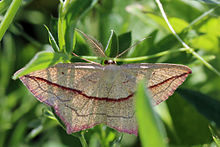|
Blood-vein
The blood-vein (Timandra comae) is a moth of the family Geometridae. The species was first described by Anton Schmidt in 1931. DistributionIt has a scattered distribution in western and central Europe north of the Alps. In the British Isles the distribution is patchy outside southern England and Wales. In far eastern Europe – east of a line running roughly from Finland through Estonia – it is replaced by its sister species Timandra griseata. The species were split in 1931, only to be subsequently re-merged by most authors. But since 1994, new research has come out in favour of treating them as distinct species.[1] Description The wings are cream coloured with bold red or purple fascia forming a diagonal stripe across forewings and hindwings. All wings are fringed with the same colour. The tornus of the hindwing is sharply angled giving a distinctive shape. The wingspan is 30–35 mm. BiologyTwo broods are produced each year with the adults flying in May and June and again in August and September.[a] It flies at night and is attracted to light. The larva is grey brown with darker spots on the back. In the UK, it feeds on the leaves of a variety of plants including dock, knotgrass, sorrel and various species of Atriplex. It overwinters as a larva. Notes
References
Bibliography
External linksWikimedia Commons has media related to Blood-vein.
|
||||||||||||||||||||||||||
